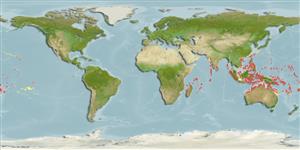>
Ovalentaria/misc (Various families in series Ovalentaria) >
Plesiopidae (Roundheads) > Plesiopinae
Etymology: Plesiops: Greek, plesios = near + Greek, ops = appearance (Ref. 45335); corallicola: Specific epithet refers to the habitat of the species, a coral-dweller (Ref. 27772).
More on author: Bleeker.
Environment: milieu / climate zone / depth range / distribution range
Ecologia
marinhas associadas(os) a recifes; intervalo de profundidade 1 - 23 m (Ref. 9710), usually 1 - 10 m (Ref. 27115). Tropical; 32°N - 24°S
Indo-Pacific: Madagascar to the Line Islands; north to southern Japan, south to the southern Great Barrier Reef and Tonga. Throughout Micronesia.
Tamanho / Peso / Idade
Maturity: Lm ? range ? - ? cm
Max length : 18.0 cm TL macho/indeterminado; (Ref. 90102)
Espinhos dorsais (total): 12; Raios dorsais moles (total): 7-8; Espinhos anais 3; Raios anais moles: 8. Coloration can vary from pale gray with black blotches and blue dots to an almost uniformly black except for the ever-present blue ocellus on the edge of its operculum.
Adults are benthic which occur inshore (Ref. 7300). Relatively common on reef flats, searching under rocks or in crevices for small fishes and crustaceans which serve as food (Ref. 1602). Common, but hidden in holes by day. They venture out to feed on small invertebrates and fishes at night (Ref. 9710). Apparently, gastropods form an important component of the diet as indicated by X-ray radiographs (Ref. 27772). Eggs are guarded by the male parent (Ref. 205). Minimum depth reported from Ref. 27115.
Life cycle and mating behavior
Maturidade | Reprodução | Desova | Ovos | Fecundidade | Larvas
Eggs are guarded by the male parent (Ref. 205).
Mooi, R.D., 1995. Revision, phylogeny, and discussion of biology and biogeography of the fish genus Plesiops (Perciformes: Plesiopsidae). Life Sci. Contrib. No. 159, 108 p. (Ref. 27772)
Categoria na Lista Vermelha da IUCN (Ref. 130435)
Ameaça para o homem
Harmless
Utilização humana
Aquário: Espécies comerciais
Mais informação
ReferênciasAquaculturaPerfil para aquaculturaEstirpesGenéticaElectrophoresesHereditariedadeDoençasProcessamentoNutrientsMass conversion
ColaboradoresFotografiasStamps, Coins Misc.SonsCiguateraVelocidadeTipo de nataçãoÁrea branquialOutras referênciasCérebrosVisão
Ferramentas
Relatórios especiais
Descarregue XML
Fontes da internet
Estimates based on models
Preferred temperature (Ref.
123201): 26.3 - 29.3, mean 28.6 °C (based on 2693 cells).
Phylogenetic diversity index (Ref.
82804): PD
50 = 0.5000 [Uniqueness, from 0.5 = low to 2.0 = high].
Bayesian length-weight: a=0.00468 (0.00177 - 0.01234), b=3.18 (2.95 - 3.41), in cm total length, based on LWR estimates for this (Sub)family-body shape (Ref.
93245).
Nível Trófico (Ref.
69278): 3.7 ±0.58 se; based on food items.
Resiliência (Ref.
120179): Médio, tempo mínimo de duplicação da população 1,4 - 4,4 anos (Preliminary K or Fecundity.).
Fishing Vulnerability (Ref.
59153): Low vulnerability (10 of 100).
Nutrients (Ref.
124155): Calcium = 86.8 [46.0, 136.3] mg/100g; Iron = 0.604 [0.370, 0.980] mg/100g; Protein = 18.6 [17.5, 19.6] %; Omega3 = 0.0952 [, ] g/100g; Selenium = 24.7 [12.4, 48.8] μg/100g; VitaminA = 131 [46, 357] μg/100g; Zinc = 1.5 [1.0, 2.1] mg/100g (wet weight);
